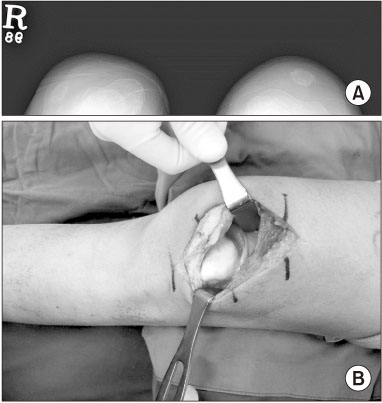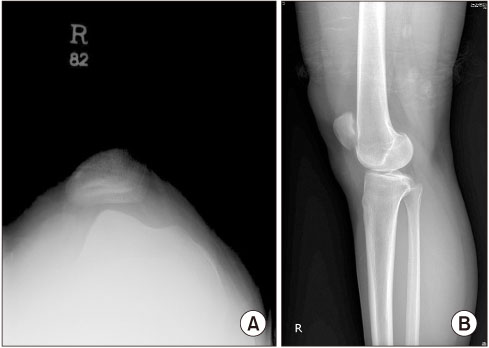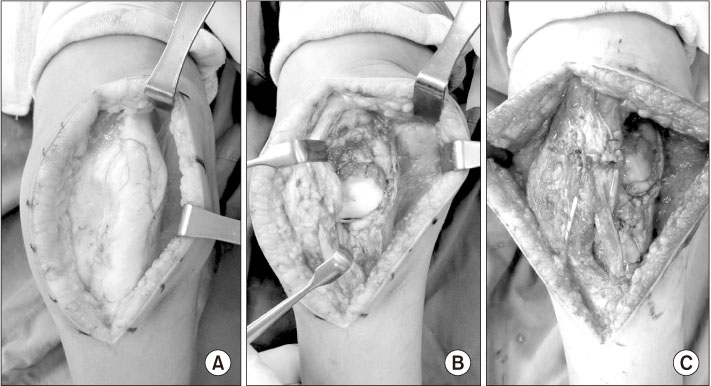J Korean Orthop Assoc.
2018 Jun;53(3):201-209. 10.4055/jkoa.2018.53.3.201.
Surgical Treatment of Patellar Instability in Children and Adolescents
- Affiliations
-
- 1Division of Orthopaedic Surgery, Severance Children's Hospital, Seoul, Korea. kunbopark@gmail.com
- 2Department of Orthopaedic Surgery, Yonsei University College of Medicine, Seoul, Korea.
- KMID: 2429167
- DOI: http://doi.org/10.4055/jkoa.2018.53.3.201
Abstract
- Patellar instability in children and adolescents is caused by abnormalities of various knee structures. Instability of the patellofemoral joint can manifest as an acute dislocation, recurrent dislocation, habitual dislocation, and congenital dislocation. Patellar instability is associated with abnormalities in the anatomical structures around the knee, and a comprehensive analysis of the cause should be undertaken. Surgery can be performed to reconstruct any abnormal musculo-skeletal alignment. Considerable progress has been made in the treatment of patellar instability in recent years, and surgical methods include lateral release, soft tissue realignment procedure, transfer of the autologous tendon, trochleaplasty, and reconstruction of the medial patellofemoral ligament.
Keyword
MeSH Terms
Figure
Reference
-
1. Herring JA. Tachdjian's pediatric orthopaedics: from the Texas Scottish rite hospital for children. 5th ed. Philadelphia: Elsevier Health Sciences;2013.2. Ghanem I, Wattincourt L, Seringe R. Congenital dislocation of the patella. Part I: pathologic anatomy. J Pediatr Orthop. 2000; 20:812–816.
Article3. Hoetzel J, Preiss A, Heitmann MA, Frosch KH. Knee injuries in children and adolescents. Eur J Trauma Emerg Surg. 2014; 40:23–36.
Article4. Sanders TL, Pareek A, Hewett TE, Stuart MJ, Dahm DL, Krych AJ. Incidence of first-time lateral patellar dislocation: a 21-year population-based study. Sports Health. 2018; 10:146–151.
Article5. Batra S. Recurrent dislocation is different from habitual dislocation of patella. Int Orthop. 2014; 38:2223.
Article6. Marsh JS, Daigneault JP, Sethi P, Polzhofer GK. Treatment of recurrent patellar instability with a modification of the Roux-Goldthwait technique. J Pediatr Orthop. 2006; 26:461–465.
Article7. Brown DE, Alexander AH, Lichtman DM. The Elmslie-Trillat procedure: evaluation in patellar dislocation and subluxation. Am J Sports Med. 1984; 12:104–109.
Article8. Baker RH, Carroll N, Dewar FP, Hall JE. The semitendinosus tenodesis for recurrent dislocation of the patella. J Bone Joint Surg Br. 1972; 54:103–109.
Article9. Seeley M, Bowman KF, Walsh C, Sabb BJ, Vanderhave KL. Magnetic resonance imaging of acute patellar dislocation in children: patterns of injury and risk factors for recurrence. J Pediatr Orthop. 2012; 32:145–155.10. Song JG, Kang SB, Oh SH, et al. Medial soft-tissue realignment versus medial patellofemoral ligament reconstruction for recurrent patellar dislocation: systematic review. Arthroscopy. 2016; 32:507–516.
Article11. Chotel F, Bérard J, Raux S. Patellar instability in children and adolescents. Orthop Traumatol Surg Res. 2014; 100:S125–S137.
Article12. Nelitz M, Reichel H, Dornacher D, Lippacher S. Anatomical reconstruction of the medial patellofemoral ligament in children with open growth-plates. Arch Orthop Trauma Surg. 2012; 132:1647–1651.
Article13. Cash JD, Hughston JC. Treatment of acute patellar dislocation. Am J Sports Med. 1988; 16:244–249.
Article14. Dimon JH 3rd. Apprehension test for subluxation of the patella. Clin Orthop Relat Res. 1974; (103):39.
Article15. Ahmad CS, McCarthy M, Gomez JA, Shubin Stein BE. The moving patellar apprehension test for lateral patellar instability. Am J Sports Med. 2009; 37:791–796.
Article16. Luhmann SJ, Smith JC, Schootman M, Prasad N. Recurrent patellar instability: implications of preoperative patellar crepitation on the status of the patellofemoral articular cartilage. J Pediatr Orthop. DOI: 10.1097/BPO.0000000000001017. Published online June 13, 2017.
Article17. Insall J, Goldberg V, Salvati E. Recurrent dislocation and the high-riding patella. Clin Orthop Relat Res. 1972; 88:67–69.
Article18. Turner MS, Smillie IS. The effect of tibial torsion of the pathology of the knee. J Bone Joint Surg Br. 1981; 63-B:396–398.
Article19. Senavongse W, Amis AA. The effects of articular, retinacular, or muscular deficiencies on patellofemoral joint stability: a biomechanical study in vitro. J Bone Joint Surg Br. 2005; 87:577–582.20. Dejour H, Walch G, Nove-Josserand L, Guier C. Factors of patellar instability: an anatomic radiographic study. Knee Surg Sports Traumatol Arthrosc. 1994; 2:19–26.
Article21. Hautamaa PV, Fithian DC, Kaufman KR, Daniel DM, Pohlmeyer AM. Medial soft tissue restraints in lateral patellar instability and repair. Clin Orthop Relat Res. 1998; (349):174–182.
Article22. Desio SM, Burks RT, Bachus KN. Soft tissue restraints to lateral patellar translation in the human knee. Am J Sports Med. 1998; 26:59–65.
Article23. Thaunat M, Erasmus PJ. The favourable anisometry: an original concept for medial patellofemoral ligament reconstruction. Knee. 2007; 14:424–428.
Article24. Askenberger M, Arendt EA, Ekström W, Voss U, Finnbogason T, Janarv PM. Medial patellofemoral ligament injuries in children with first-time lateral patellar dislocations: a magnetic resonance imaging and arthroscopic study. Am J Sports Med. 2016; 44:152–158.25. Mendez AA, Keret D, MacEwen GD. Treatment of patellofemoral instability in Down's syndrome. Clin Orthop Relat Res. 1988; (234):148–158.
Article26. Mizuta H, Kubota K, Shiraishi M, Nakamura E, Takagi K, Iwatani N. Recurrent dislocation of the patella in Turner's syndrome. J Pediatr Orthop. 1994; 14:74–77.
Article27. Philippot R, Boyer B, Testa R, Farizon F, Moyen B. The role of the medial ligamentous structures on patellar tracking during knee flexion. Knee Surg Sports Traumatol Arthrosc. 2012; 20:331–336.
Article28. Nietosvaara Y, Aalto K, Kallio PE. Acute patellar dislocation in children: incidence and associated osteochondral fractures. J Pediatr Orthop. 1994; 14:513–515.
Article29. Insall J, Salvati E. Patella position in the normal knee joint. Radiology. 1971; 101:101–104.
Article30. Hughston JC. Subluxation of the patella. J Bone Joint Surg Am. 1968; 50:1003–1026.
Article31. Merchant AC, Mercer RL, Jacobsen RH, Cool CR. Roentgenographic analysis of patellofemoral congruence. J Bone Joint Surg Am. 1974; 56:1391–1396.
Article32. Laurin CA, Lévesque HP, Dussault R, Labelle H, Peides JP. The abnormal lateral patellofemoral angle: a diagnostic roentgenographic sign of recurrent patellar subluxation. J Bone Joint Surg Am. 1978; 60:55–60.33. Fithian DC, Mishra DK, Balen PF, Stone ML, Daniel DM. Instrumented measurement of patellar mobility. Am J Sports Med. 1995; 23:607–615.
Article34. Balcarek P, Jung K, Frosch KH, Stürmer KM. Value of the tibial tuberosity-trochlear groove distance in patellar instability in the young athlete. Am J Sports Med. 2011; 39:1756–1761.
Article35. Kirsch MD, Fitzgerald SW, Friedman H, Rogers LF. Transient lateral patellar dislocation: diagnosis with MR imaging. AJR Am J Roentgenol. 1993; 161:109–113.
Article36. Balcarek P, Ammon J, Frosch S, et al. Magnetic resonance imaging characteristics of the medial patellofemoral ligament lesion in acute lateral patellar dislocations considering trochlear dysplasia, patella alta, and tibial tuberosity-trochlear groove distance. Arthroscopy. 2010; 26:926–935.
Article37. Tegner Y, Lysholm J. Rating systems in the evaluation of knee ligament injuries. Clin Orthop Relat Res. 1985; (198):43–49.
Article38. Palmu S, Kallio PE, Donell ST, Helenius I, Nietosvaara Y. Acute patellar dislocation in children and adolescents: a randomized clinical trial. J Bone Joint Surg Am. 2008; 90:463–470.
Article39. Fithian DC, Paxton EW, Stone ML, et al. Epidemiology and natural history of acute patellar dislocation. Am J Sports Med. 2004; 32:1114–1121.
Article40. Gerbino PG, Zurakowski D, Soto R, Griffin E, Reig TS, Micheli LJ. Long-term functional outcome after lateral patellar retinacular release in adolescents: an observational cohort study with minimum 5-year follow-up. J Pediatr Orthop. 2008; 28:118–123.41. Weinstein SL, Flynn JM. Lovell and Winter's pediatric orthopaedics. 7th ed. Philadelphia: Lippincott Williams & Wilkins;2014.42. Insall J, Bullough PG, Burstein AH. Proximal “tube” realignment of the patella for chondromalacia patellae. Clin Orthop Relat Res. 1979; (144):63–69.
Article43. Seitlinger G, Scheurecker G, Högler R, Labey L, Innocenti B, Hofmann S. Tibial tubercle-posterior cruciate ligament distance: a new measurement to define the position of the tibial tubercle in patients with patellar dislocation. Am J Sports Med. 2012; 40:1119–1125.44. Joo SY, Park KB, Kim BR, Park HW, Kim HW. The ‘four-in-one’ procedure for habitual dislocation of the patella in children: early results in patients with severe generalised ligamentous laxity and aplasis of the trochlear groove. J Bone Joint Surg Br. 2007; 89:1645–1649.45. Shea KG, Styhl AC, Jacobs JC Jr, et al. The relationship of the femoral physis and the medial patellofemoral ligament in children: a cadaveric study. Am J Sports Med. 2016; 44:2833–2837.46. Nelitz M, Williams RS, Lippacher S, Reichel H, Dornacher D. Analysis of failure and clinical outcome after unsuccessful medial patellofemoral ligament reconstruction in young patients. Int Orthop. 2014; 38:2265–2272.
Article47. Shea KG, Martinson WD, Cannamela PC, et al. Variation in the medial patellofemoral ligament origin in the skeletally immature knee: an anatomic study. Am J Sports Med. 2018; 46:363–369.
Article48. Flynn JM, Wiesel SW. Operative techniques in pediatric orthopaedics. Philadelphia: Lippincott Williams & Wilkins;2010.49. Seitlinger G, Moroder P, Fink C, Wierer G. Acquired femoral flexion deformity due to physeal injury during medial patellofemoral ligament reconstruction. Knee. 2017; 24:680–685.
Article50. Nguyen CV, Farrow LD, Liu RW, Gilmore A. Safe drilling paths in the distal femoral epiphysis for pediatric medial patellofemoral ligament reconstruction. Am J Sports Med. 2017; 45:1085–1089.
Article51. Nelitz M, Dreyhaupt J, Williams SRM. Anatomic reconstruction of the medial patellofemoral ligament in children and adolescents using a pedicled quadriceps tendon graft shows favourable results at a minimum of 2-year follow-up. Knee Surg Sports Traumatol Arthrosc. 2018; 26:1210–1215.
Article52. Stephen JM, Kittl C, Williams A, et al. Effect of medial patellofemoral ligament reconstruction method on patellofemoral contact pressures and kinematics. Am J Sports Med. 2016; 44:1186–1194.
Article53. Noyes FR, Albright JC. Reconstruction of the medial patellofemoral ligament with autologous quadriceps tendon. Arthroscopy. 2006; 22:904.e1–904.e7.
Article54. Alm L, Krause M, Mull C, Frosch KH, Akoto R. Modified adductor sling technique: a surgical therapy for patellar instability in skeletally immature patients. Knee. 2017; 24:1282–1288.
Article55. Hohn E, Pandya NK. Does the utilization of allograft tissue in medial patellofemoral ligament reconstruction in pediatric and adolescent patients restore patellar stability? Clin Orthop Relat Res. 2017; 475:1563–1569.
Article56. Shah JN, Howard JS, Flanigan DC, Brophy RH, Carey JL, Lattermann C. A systematic review of complications and failures associated with medial patellofemoral ligament reconstruction for recurrent patellar dislocation. Am J Sports Med. 2012; 40:1916–1923.
Article57. Sadigursky D, Garcia LC, Armede M, Oliveira LR, Carneiro RJF, Colavolpe PO. Medial patellofemoral ligament and medial patellotibial ligament reconstruction in children: preliminary results. Rev Bras Ortop. 2017; 52:417–422.
Article58. Swarup I, Elattar O, Rozbruch SR. Patellar instability treated with distal femoral osteotomy. Knee. 2017; 24:608–614.
Article59. Kwon JH, Kim JI, Seo DH, Kang KW, Nam JH, Nha KW. Patellar dislocation with genu valgum treated by DFO. Orthopedics. 2013; 36:840–843.
Article60. Nelitz M, Dreyhaupt J, Williams SR, Dornacher D. Combined supracondylar femoral derotation osteotomy and patellofemoral ligament reconstruction for recurrent patellar dislocation and severe femoral anteversion syndrome: surgical technique and clinical outcome. Int Orthop. 2015; 39:2355–2362.
Article61. Zimmerer A, Sobau C, Balcarek P. Recent developments in evaluation and treatment of lateral patellar instability. J Exp Orthop. 2018; 5:3.
Article62. Utting MR, Mulford JS, Eldridge JD. A prospective evaluation of trochleoplasty for the treatment of patellofemoral dislocation and instability. J Bone Joint Surg Br. 2008; 90:180–185.
Article63. Pesenti S, Ollivier M, Escudier JC, et al. Medial patellofemoral ligament reconstruction in children: do osseous abnormalities matter? Int Orthop. 2018; 42:1357–1362.
Article64. Balcarek P, Rehn S, Howells NR, et al. Results of medial patellofemoral ligament reconstruction compared with trochleoplasty plus individual extensor apparatus balancing in patellar instability caused by severe trochlear dysplasia: a systematic review and meta-analysis. Knee Surg Sports Traumatol Arthrosc. 2017; 25:3869–3877.
Article65. Longo UG, Vincenzo C, Mannering N, et al. Trochleoplasty techniques provide good clinical results in patients with trochlear dysplasia. Knee Surg Sports Traumatol Arthrosc. DOI: 10.1007/s00167-017-4584-9. Published online May 31, 2017.
Article66. Dejour D, Le Coultre B. Osteotomies in patello-femoral instabilities. Sports Med Arthrosc Rev. 2007; 15:39–46.
Article67. von Knoch F, Böhm T, Bürgi ML, von Knoch M, Bereiter H. Trochleaplasty for recurrent patellar dislocation in association with trochlear dysplasia. A 4- to 14-year follow-up study. J Bone Joint Surg Br. 2006; 88:1331–1335.68. Jaquith BP, Parikh SN. Predictors of recurrent patellar instability in children and adolescents after first-time dislocation. J Pediatr Orthop. 2017; 37:484–490.
Article69. Arnbjörnsson A, Egund N, Rydling O, Stockerup R, Ryd L. The natural history of recurrent dislocation of the patella. Long-term results of conservative and operative treatment. J Bone Joint Surg Br. 1992; 74:140–142.70. Luhmann SJ, O'Donnell JC, Fuhrhop S. Outcomes after patellar realignment surgery for recurrent patellar instability dislocations: a minimum 3-year follow-up study of children and adolescents. J Pediatr Orthop. 2011; 31:65–71.71. Nomura E, Inoue M, Kobayashi S. Long-term follow-up and knee osteoarthritis change after medial patellofemoral ligament reconstruction for recurrent patellar dislocation. Am J Sports Med. 2007; 35:1851–1858.
Article72. Krych AJ, O'Malley MP, Johnson NR, et al. Functional testing and return to sport following stabilization surgery for recurrent lateral patellar instability in competitive athletes. Knee Surg Sports Traumatol Arthrosc. 2018; 26:711–718.
Article
- Full Text Links
- Actions
-
Cited
- CITED
-
- Close
- Share
- Similar articles
-
- Patellofemoral Instability in Children: Imaging Findings and Therapeutic Approaches
- Diagnosis and treatment of patellofemoral joint instability
- The Reconstruction of Anterior Cruciate Ligament Using Patellar Tendon under Arthroscopy
- Surgical Treatment for Chronic Rupture of the Patellar Tendon Replaced by Fibrotic Scar Tissue
- Results of Recurrent Patellar Instability after Trauma According to Anatomical Predisposing Factors





